University Nursing Research Assignment: A Study Critique
VerifiedAdded on 2021/04/17
|8
|1411
|80
Report
AI Summary
This report provides a comprehensive critique of a qualitative research paper titled, “Communication between family carers and health professionals about end-of-life care for older people in the acute hospital setting: a qualitative study” by Caswell et al. (2015). The assignment examines various aspects of the study, including the title, abstract, introduction, literature review, methodology, results, discussion, and conclusion. The critique assesses the strengths and weaknesses of each section, such as the clarity of the abstract, the comprehensiveness of the literature review, the appropriateness of the methodology, and the presentation of results. The report highlights the significance of the study's findings in relation to nursing practice, particularly in the context of end-of-life care and communication between healthcare providers and family members. The analysis also considers the limitations of the study and its implications for future research and practice, emphasizing the importance of effective communication in improving patient outcomes and the family experience. The report references several supporting studies and guidelines to provide a well-rounded evaluation of the research paper.
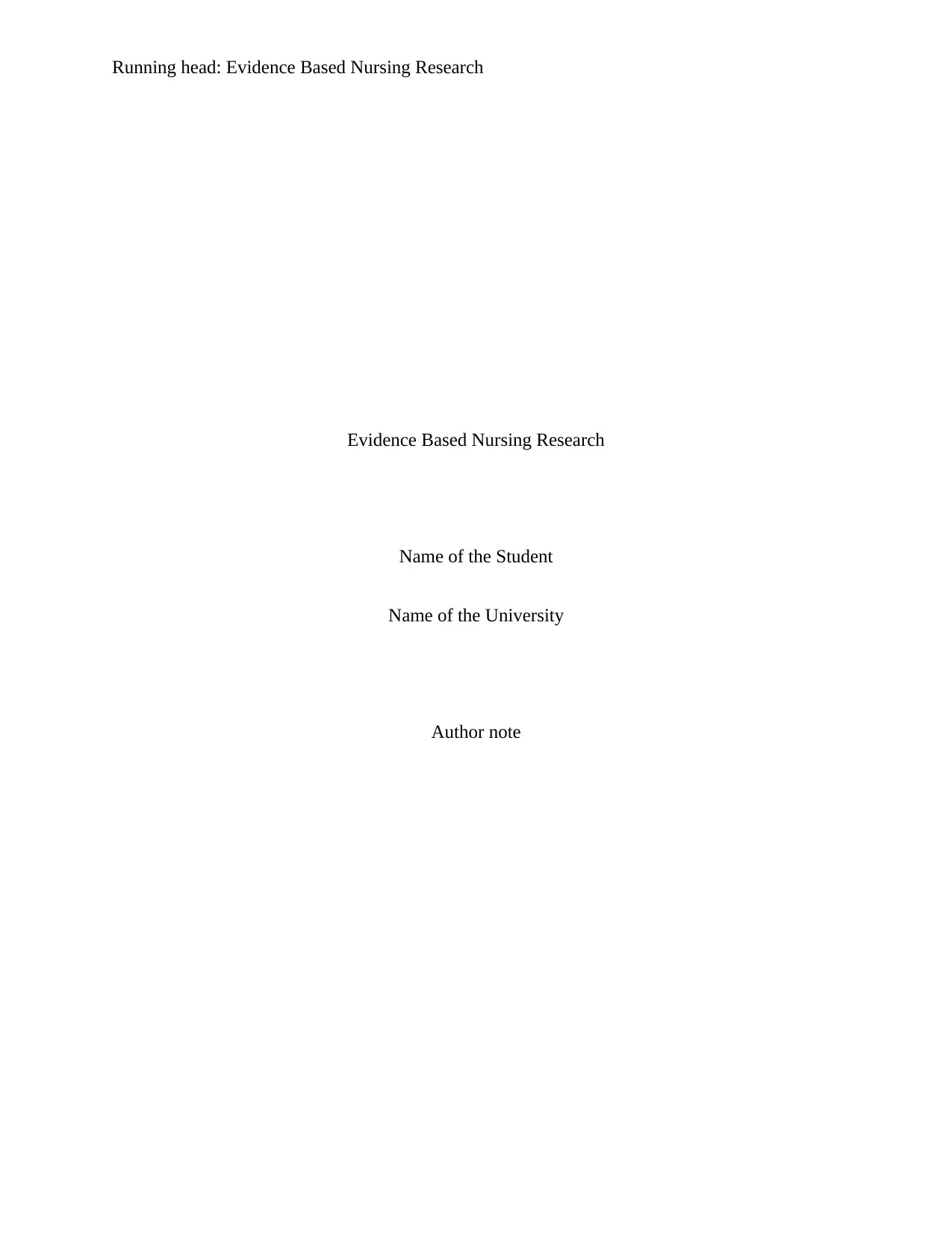
Running head: Evidence Based Nursing Research
Evidence Based Nursing Research
Name of the Student
Name of the University
Author note
Evidence Based Nursing Research
Name of the Student
Name of the University
Author note
Paraphrase This Document
Need a fresh take? Get an instant paraphrase of this document with our AI Paraphraser
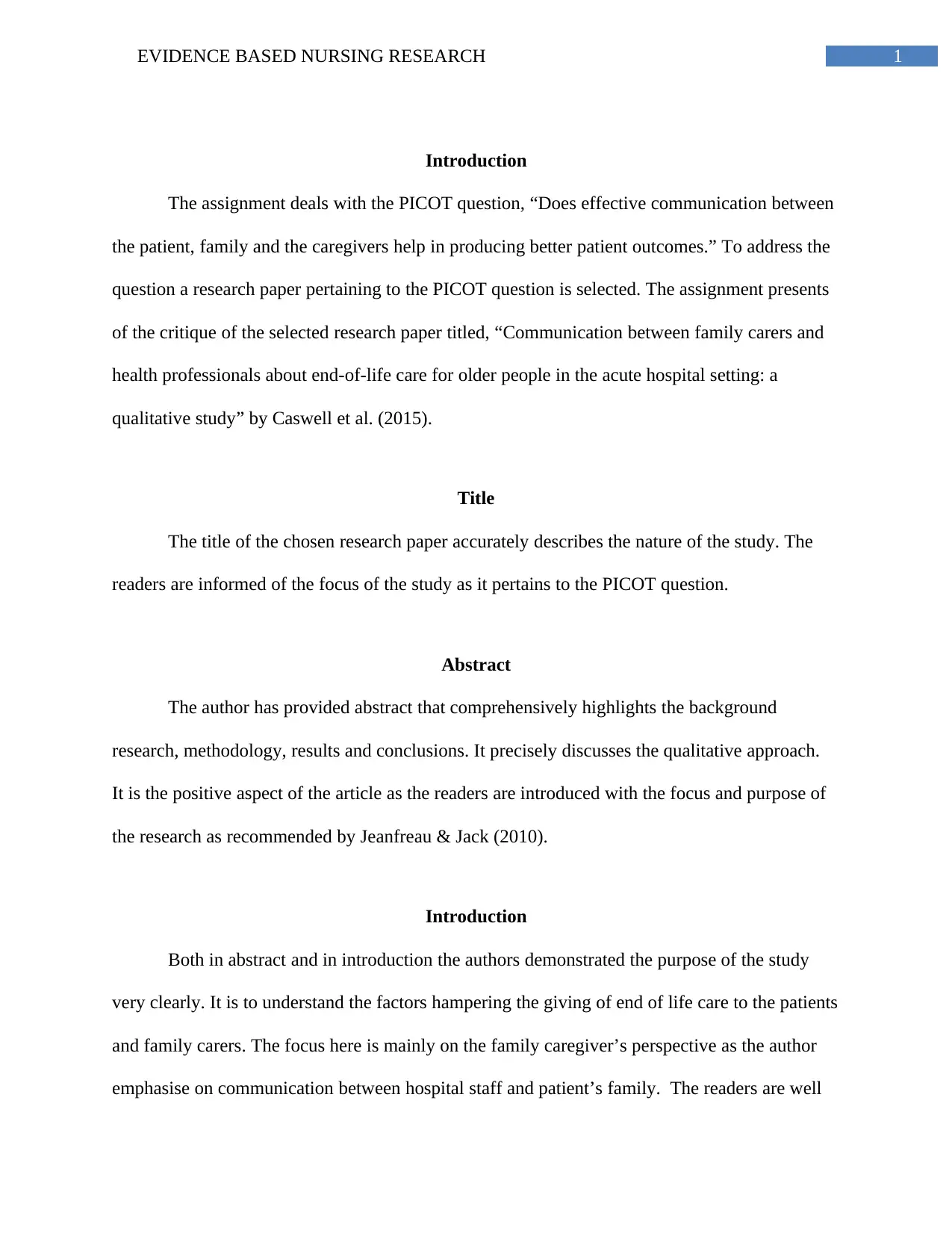
1EVIDENCE BASED NURSING RESEARCH
Introduction
The assignment deals with the PICOT question, “Does effective communication between
the patient, family and the caregivers help in producing better patient outcomes.” To address the
question a research paper pertaining to the PICOT question is selected. The assignment presents
of the critique of the selected research paper titled, “Communication between family carers and
health professionals about end-of-life care for older people in the acute hospital setting: a
qualitative study” by Caswell et al. (2015).
Title
The title of the chosen research paper accurately describes the nature of the study. The
readers are informed of the focus of the study as it pertains to the PICOT question.
Abstract
The author has provided abstract that comprehensively highlights the background
research, methodology, results and conclusions. It precisely discusses the qualitative approach.
It is the positive aspect of the article as the readers are introduced with the focus and purpose of
the research as recommended by Jeanfreau & Jack (2010).
Introduction
Both in abstract and in introduction the authors demonstrated the purpose of the study
very clearly. It is to understand the factors hampering the giving of end of life care to the patients
and family carers. The focus here is mainly on the family caregiver’s perspective as the author
emphasise on communication between hospital staff and patient’s family. The readers are well
Introduction
The assignment deals with the PICOT question, “Does effective communication between
the patient, family and the caregivers help in producing better patient outcomes.” To address the
question a research paper pertaining to the PICOT question is selected. The assignment presents
of the critique of the selected research paper titled, “Communication between family carers and
health professionals about end-of-life care for older people in the acute hospital setting: a
qualitative study” by Caswell et al. (2015).
Title
The title of the chosen research paper accurately describes the nature of the study. The
readers are informed of the focus of the study as it pertains to the PICOT question.
Abstract
The author has provided abstract that comprehensively highlights the background
research, methodology, results and conclusions. It precisely discusses the qualitative approach.
It is the positive aspect of the article as the readers are introduced with the focus and purpose of
the research as recommended by Jeanfreau & Jack (2010).
Introduction
Both in abstract and in introduction the authors demonstrated the purpose of the study
very clearly. It is to understand the factors hampering the giving of end of life care to the patients
and family carers. The focus here is mainly on the family caregiver’s perspective as the author
emphasise on communication between hospital staff and patient’s family. The readers are well
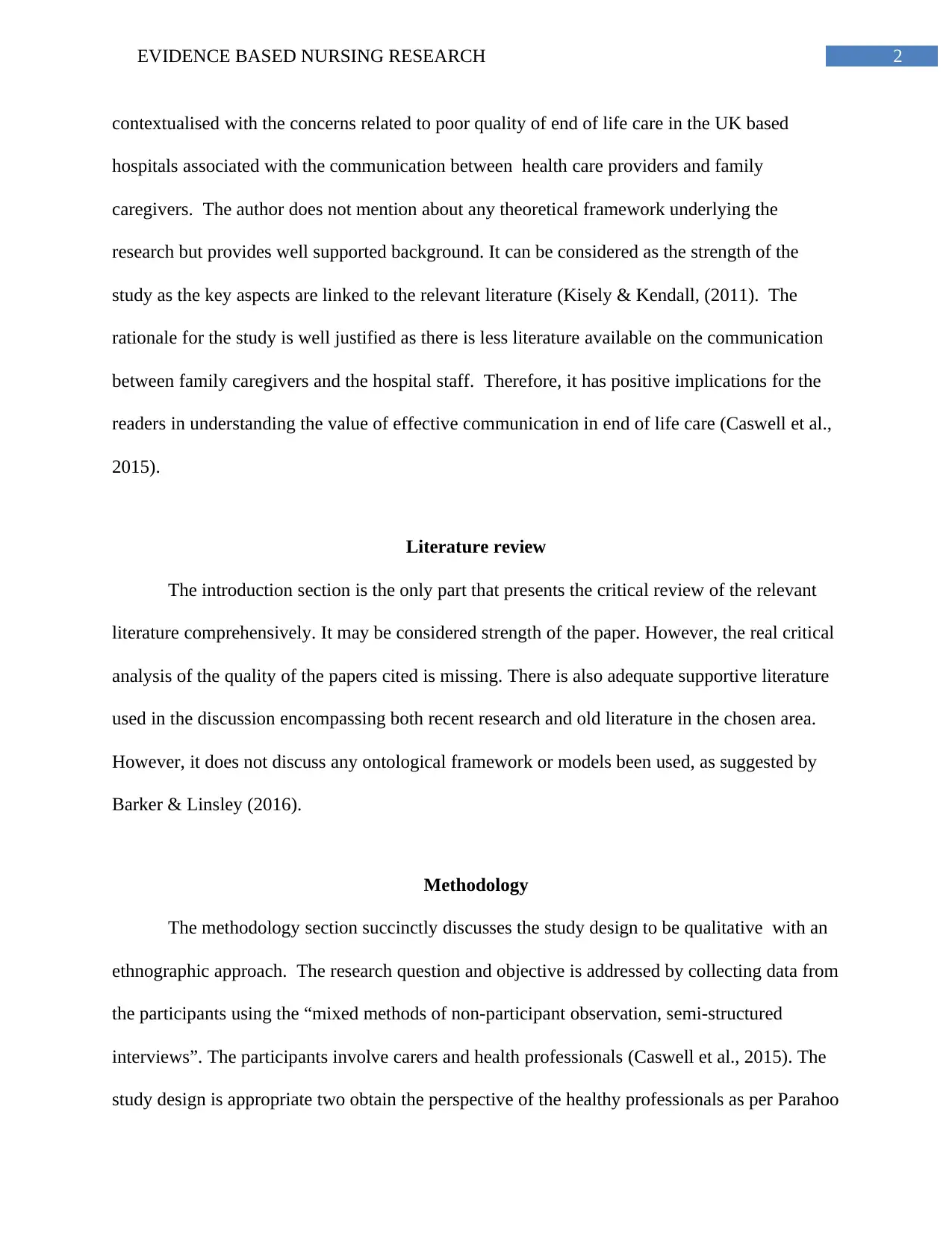
2EVIDENCE BASED NURSING RESEARCH
contextualised with the concerns related to poor quality of end of life care in the UK based
hospitals associated with the communication between health care providers and family
caregivers. The author does not mention about any theoretical framework underlying the
research but provides well supported background. It can be considered as the strength of the
study as the key aspects are linked to the relevant literature (Kisely & Kendall, (2011). The
rationale for the study is well justified as there is less literature available on the communication
between family caregivers and the hospital staff. Therefore, it has positive implications for the
readers in understanding the value of effective communication in end of life care (Caswell et al.,
2015).
Literature review
The introduction section is the only part that presents the critical review of the relevant
literature comprehensively. It may be considered strength of the paper. However, the real critical
analysis of the quality of the papers cited is missing. There is also adequate supportive literature
used in the discussion encompassing both recent research and old literature in the chosen area.
However, it does not discuss any ontological framework or models been used, as suggested by
Barker & Linsley (2016).
Methodology
The methodology section succinctly discusses the study design to be qualitative with an
ethnographic approach. The research question and objective is addressed by collecting data from
the participants using the “mixed methods of non-participant observation, semi-structured
interviews”. The participants involve carers and health professionals (Caswell et al., 2015). The
study design is appropriate two obtain the perspective of the healthy professionals as per Parahoo
contextualised with the concerns related to poor quality of end of life care in the UK based
hospitals associated with the communication between health care providers and family
caregivers. The author does not mention about any theoretical framework underlying the
research but provides well supported background. It can be considered as the strength of the
study as the key aspects are linked to the relevant literature (Kisely & Kendall, (2011). The
rationale for the study is well justified as there is less literature available on the communication
between family caregivers and the hospital staff. Therefore, it has positive implications for the
readers in understanding the value of effective communication in end of life care (Caswell et al.,
2015).
Literature review
The introduction section is the only part that presents the critical review of the relevant
literature comprehensively. It may be considered strength of the paper. However, the real critical
analysis of the quality of the papers cited is missing. There is also adequate supportive literature
used in the discussion encompassing both recent research and old literature in the chosen area.
However, it does not discuss any ontological framework or models been used, as suggested by
Barker & Linsley (2016).
Methodology
The methodology section succinctly discusses the study design to be qualitative with an
ethnographic approach. The research question and objective is addressed by collecting data from
the participants using the “mixed methods of non-participant observation, semi-structured
interviews”. The participants involve carers and health professionals (Caswell et al., 2015). The
study design is appropriate two obtain the perspective of the healthy professionals as per Parahoo
⊘ This is a preview!⊘
Do you want full access?
Subscribe today to unlock all pages.

Trusted by 1+ million students worldwide
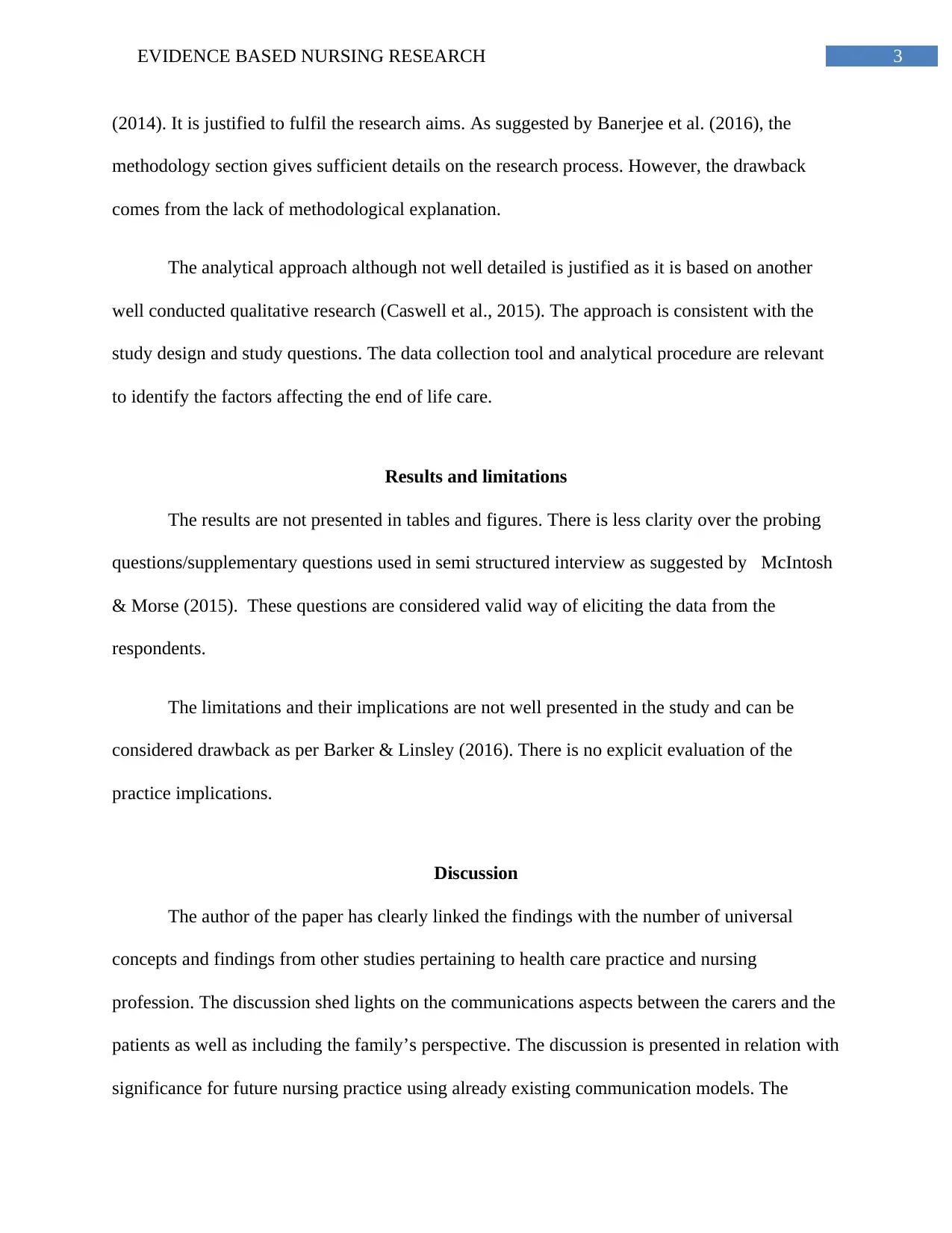
3EVIDENCE BASED NURSING RESEARCH
(2014). It is justified to fulfil the research aims. As suggested by Banerjee et al. (2016), the
methodology section gives sufficient details on the research process. However, the drawback
comes from the lack of methodological explanation.
The analytical approach although not well detailed is justified as it is based on another
well conducted qualitative research (Caswell et al., 2015). The approach is consistent with the
study design and study questions. The data collection tool and analytical procedure are relevant
to identify the factors affecting the end of life care.
Results and limitations
The results are not presented in tables and figures. There is less clarity over the probing
questions/supplementary questions used in semi structured interview as suggested by McIntosh
& Morse (2015). These questions are considered valid way of eliciting the data from the
respondents.
The limitations and their implications are not well presented in the study and can be
considered drawback as per Barker & Linsley (2016). There is no explicit evaluation of the
practice implications.
Discussion
The author of the paper has clearly linked the findings with the number of universal
concepts and findings from other studies pertaining to health care practice and nursing
profession. The discussion shed lights on the communications aspects between the carers and the
patients as well as including the family’s perspective. The discussion is presented in relation with
significance for future nursing practice using already existing communication models. The
(2014). It is justified to fulfil the research aims. As suggested by Banerjee et al. (2016), the
methodology section gives sufficient details on the research process. However, the drawback
comes from the lack of methodological explanation.
The analytical approach although not well detailed is justified as it is based on another
well conducted qualitative research (Caswell et al., 2015). The approach is consistent with the
study design and study questions. The data collection tool and analytical procedure are relevant
to identify the factors affecting the end of life care.
Results and limitations
The results are not presented in tables and figures. There is less clarity over the probing
questions/supplementary questions used in semi structured interview as suggested by McIntosh
& Morse (2015). These questions are considered valid way of eliciting the data from the
respondents.
The limitations and their implications are not well presented in the study and can be
considered drawback as per Barker & Linsley (2016). There is no explicit evaluation of the
practice implications.
Discussion
The author of the paper has clearly linked the findings with the number of universal
concepts and findings from other studies pertaining to health care practice and nursing
profession. The discussion shed lights on the communications aspects between the carers and the
patients as well as including the family’s perspective. The discussion is presented in relation with
significance for future nursing practice using already existing communication models. The
Paraphrase This Document
Need a fresh take? Get an instant paraphrase of this document with our AI Paraphraser
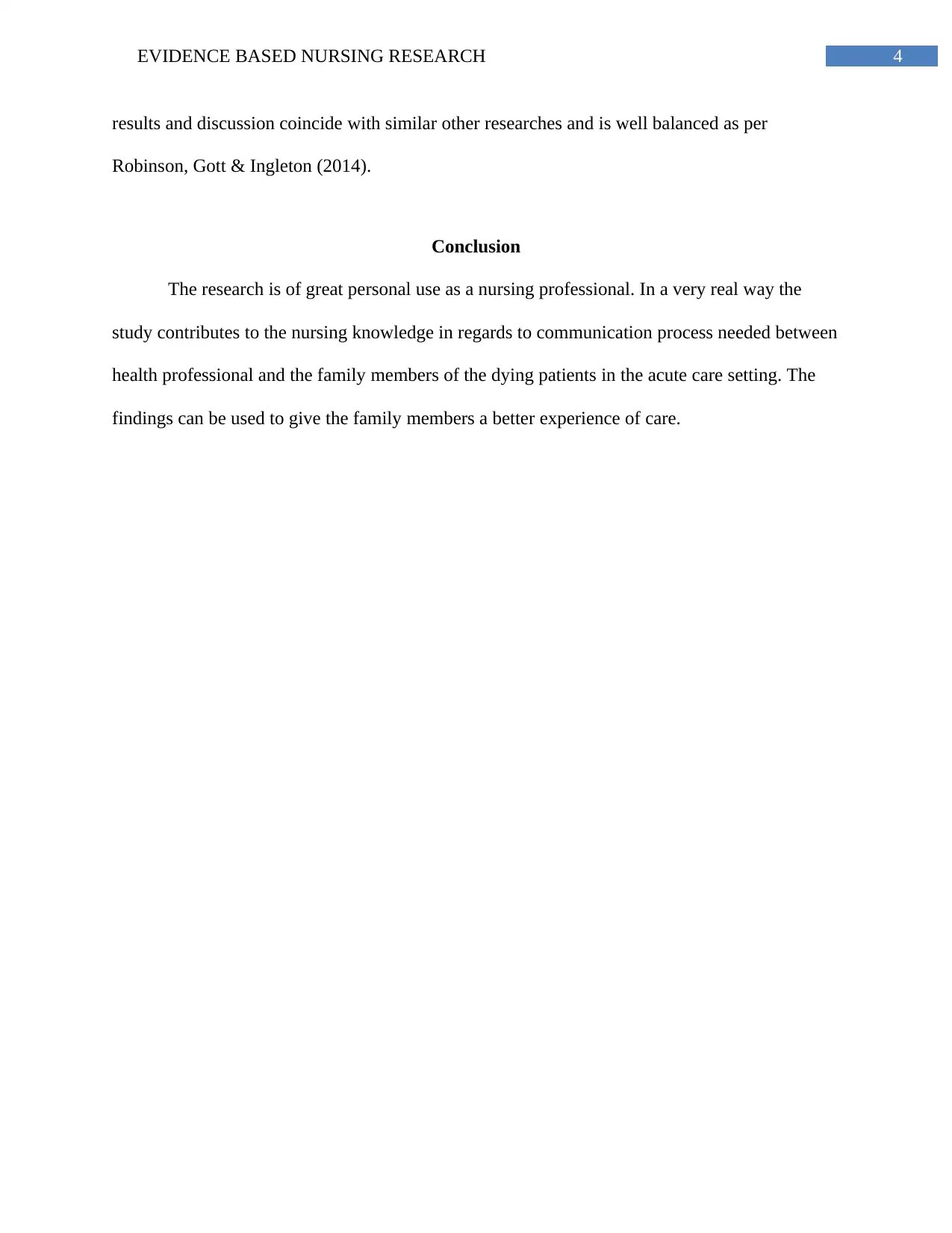
4EVIDENCE BASED NURSING RESEARCH
results and discussion coincide with similar other researches and is well balanced as per
Robinson, Gott & Ingleton (2014).
Conclusion
The research is of great personal use as a nursing professional. In a very real way the
study contributes to the nursing knowledge in regards to communication process needed between
health professional and the family members of the dying patients in the acute care setting. The
findings can be used to give the family members a better experience of care.
results and discussion coincide with similar other researches and is well balanced as per
Robinson, Gott & Ingleton (2014).
Conclusion
The research is of great personal use as a nursing professional. In a very real way the
study contributes to the nursing knowledge in regards to communication process needed between
health professional and the family members of the dying patients in the acute care setting. The
findings can be used to give the family members a better experience of care.
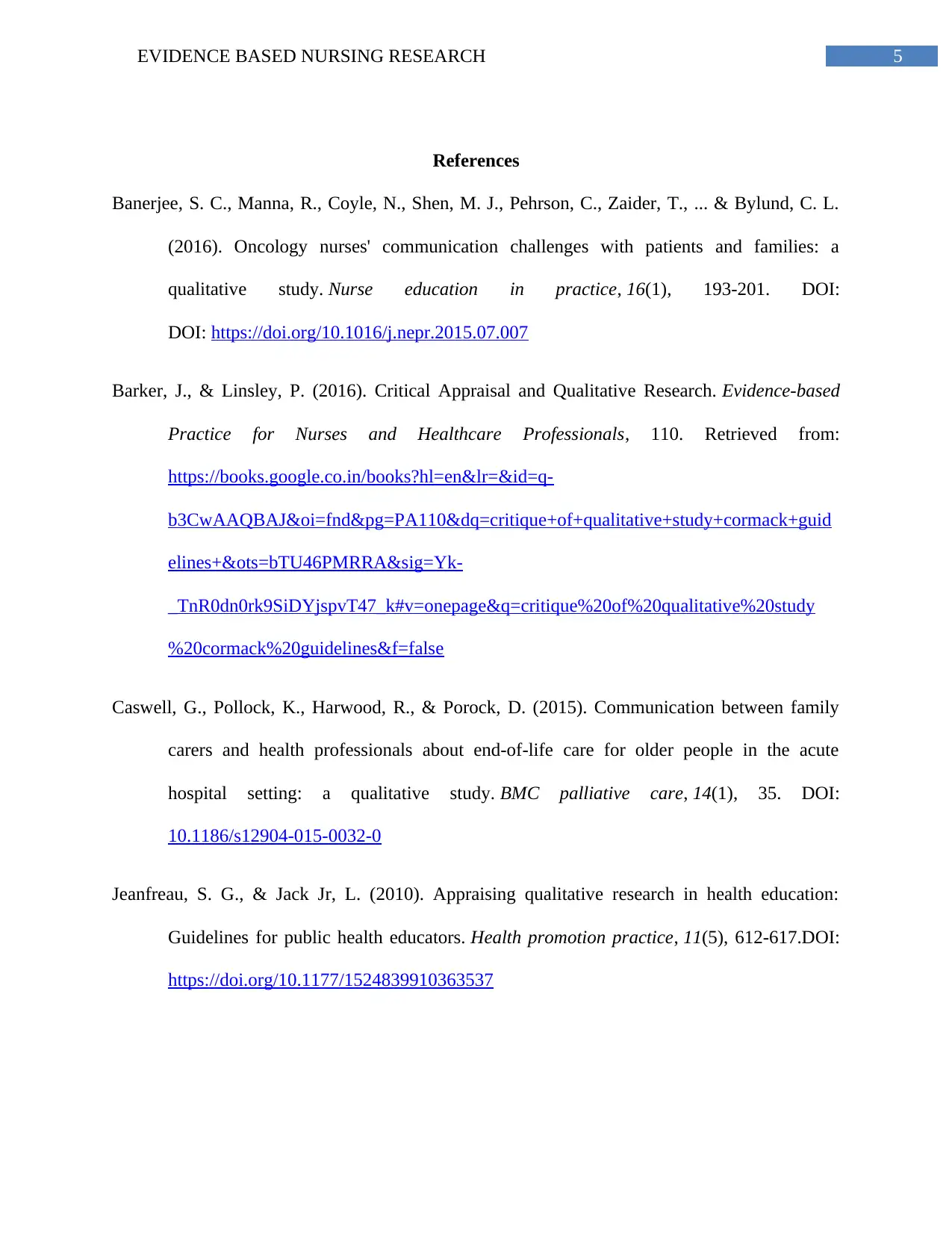
5EVIDENCE BASED NURSING RESEARCH
References
Banerjee, S. C., Manna, R., Coyle, N., Shen, M. J., Pehrson, C., Zaider, T., ... & Bylund, C. L.
(2016). Oncology nurses' communication challenges with patients and families: a
qualitative study. Nurse education in practice, 16(1), 193-201. DOI:
DOI: https://doi.org/10.1016/j.nepr.2015.07.007
Barker, J., & Linsley, P. (2016). Critical Appraisal and Qualitative Research. Evidence-based
Practice for Nurses and Healthcare Professionals, 110. Retrieved from:
https://books.google.co.in/books?hl=en&lr=&id=q-
b3CwAAQBAJ&oi=fnd&pg=PA110&dq=critique+of+qualitative+study+cormack+guid
elines+&ots=bTU46PMRRA&sig=Yk-
_TnR0dn0rk9SiDYjspvT47_k#v=onepage&q=critique%20of%20qualitative%20study
%20cormack%20guidelines&f=false
Caswell, G., Pollock, K., Harwood, R., & Porock, D. (2015). Communication between family
carers and health professionals about end-of-life care for older people in the acute
hospital setting: a qualitative study. BMC palliative care, 14(1), 35. DOI:
10.1186/s12904-015-0032-0
Jeanfreau, S. G., & Jack Jr, L. (2010). Appraising qualitative research in health education:
Guidelines for public health educators. Health promotion practice, 11(5), 612-617.DOI:
https://doi.org/10.1177/1524839910363537
References
Banerjee, S. C., Manna, R., Coyle, N., Shen, M. J., Pehrson, C., Zaider, T., ... & Bylund, C. L.
(2016). Oncology nurses' communication challenges with patients and families: a
qualitative study. Nurse education in practice, 16(1), 193-201. DOI:
DOI: https://doi.org/10.1016/j.nepr.2015.07.007
Barker, J., & Linsley, P. (2016). Critical Appraisal and Qualitative Research. Evidence-based
Practice for Nurses and Healthcare Professionals, 110. Retrieved from:
https://books.google.co.in/books?hl=en&lr=&id=q-
b3CwAAQBAJ&oi=fnd&pg=PA110&dq=critique+of+qualitative+study+cormack+guid
elines+&ots=bTU46PMRRA&sig=Yk-
_TnR0dn0rk9SiDYjspvT47_k#v=onepage&q=critique%20of%20qualitative%20study
%20cormack%20guidelines&f=false
Caswell, G., Pollock, K., Harwood, R., & Porock, D. (2015). Communication between family
carers and health professionals about end-of-life care for older people in the acute
hospital setting: a qualitative study. BMC palliative care, 14(1), 35. DOI:
10.1186/s12904-015-0032-0
Jeanfreau, S. G., & Jack Jr, L. (2010). Appraising qualitative research in health education:
Guidelines for public health educators. Health promotion practice, 11(5), 612-617.DOI:
https://doi.org/10.1177/1524839910363537
⊘ This is a preview!⊘
Do you want full access?
Subscribe today to unlock all pages.

Trusted by 1+ million students worldwide
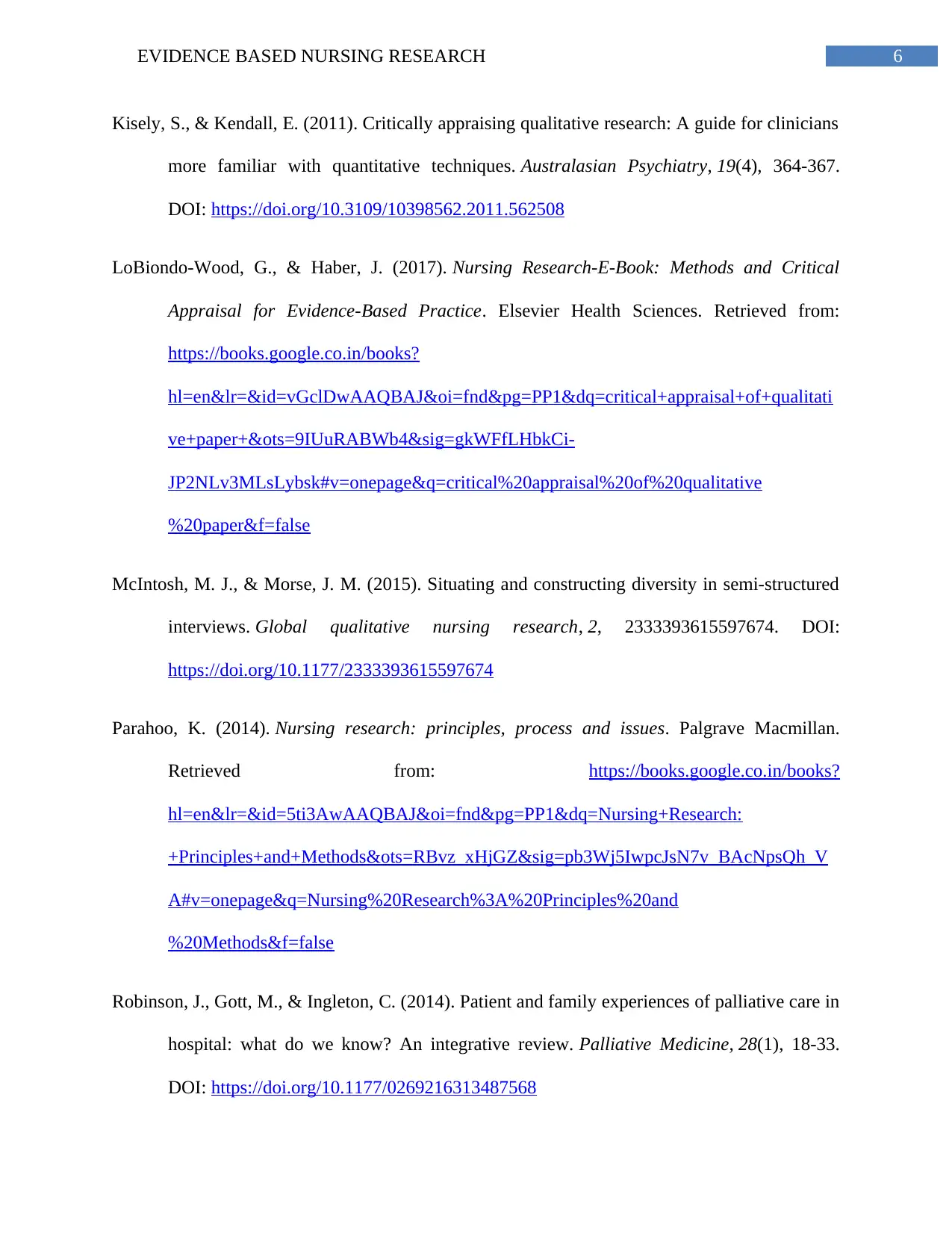
6EVIDENCE BASED NURSING RESEARCH
Kisely, S., & Kendall, E. (2011). Critically appraising qualitative research: A guide for clinicians
more familiar with quantitative techniques. Australasian Psychiatry, 19(4), 364-367.
DOI: https://doi.org/10.3109/10398562.2011.562508
LoBiondo-Wood, G., & Haber, J. (2017). Nursing Research-E-Book: Methods and Critical
Appraisal for Evidence-Based Practice. Elsevier Health Sciences. Retrieved from:
https://books.google.co.in/books?
hl=en&lr=&id=vGclDwAAQBAJ&oi=fnd&pg=PP1&dq=critical+appraisal+of+qualitati
ve+paper+&ots=9IUuRABWb4&sig=gkWFfLHbkCi-
JP2NLv3MLsLybsk#v=onepage&q=critical%20appraisal%20of%20qualitative
%20paper&f=false
McIntosh, M. J., & Morse, J. M. (2015). Situating and constructing diversity in semi-structured
interviews. Global qualitative nursing research, 2, 2333393615597674. DOI:
https://doi.org/10.1177/2333393615597674
Parahoo, K. (2014). Nursing research: principles, process and issues. Palgrave Macmillan.
Retrieved from: https://books.google.co.in/books?
hl=en&lr=&id=5ti3AwAAQBAJ&oi=fnd&pg=PP1&dq=Nursing+Research:
+Principles+and+Methods&ots=RBvz_xHjGZ&sig=pb3Wj5IwpcJsN7v_BAcNpsQh_V
A#v=onepage&q=Nursing%20Research%3A%20Principles%20and
%20Methods&f=false
Robinson, J., Gott, M., & Ingleton, C. (2014). Patient and family experiences of palliative care in
hospital: what do we know? An integrative review. Palliative Medicine, 28(1), 18-33.
DOI: https://doi.org/10.1177/0269216313487568
Kisely, S., & Kendall, E. (2011). Critically appraising qualitative research: A guide for clinicians
more familiar with quantitative techniques. Australasian Psychiatry, 19(4), 364-367.
DOI: https://doi.org/10.3109/10398562.2011.562508
LoBiondo-Wood, G., & Haber, J. (2017). Nursing Research-E-Book: Methods and Critical
Appraisal for Evidence-Based Practice. Elsevier Health Sciences. Retrieved from:
https://books.google.co.in/books?
hl=en&lr=&id=vGclDwAAQBAJ&oi=fnd&pg=PP1&dq=critical+appraisal+of+qualitati
ve+paper+&ots=9IUuRABWb4&sig=gkWFfLHbkCi-
JP2NLv3MLsLybsk#v=onepage&q=critical%20appraisal%20of%20qualitative
%20paper&f=false
McIntosh, M. J., & Morse, J. M. (2015). Situating and constructing diversity in semi-structured
interviews. Global qualitative nursing research, 2, 2333393615597674. DOI:
https://doi.org/10.1177/2333393615597674
Parahoo, K. (2014). Nursing research: principles, process and issues. Palgrave Macmillan.
Retrieved from: https://books.google.co.in/books?
hl=en&lr=&id=5ti3AwAAQBAJ&oi=fnd&pg=PP1&dq=Nursing+Research:
+Principles+and+Methods&ots=RBvz_xHjGZ&sig=pb3Wj5IwpcJsN7v_BAcNpsQh_V
A#v=onepage&q=Nursing%20Research%3A%20Principles%20and
%20Methods&f=false
Robinson, J., Gott, M., & Ingleton, C. (2014). Patient and family experiences of palliative care in
hospital: what do we know? An integrative review. Palliative Medicine, 28(1), 18-33.
DOI: https://doi.org/10.1177/0269216313487568
Paraphrase This Document
Need a fresh take? Get an instant paraphrase of this document with our AI Paraphraser

7EVIDENCE BASED NURSING RESEARCH
1 out of 8
Related Documents
Your All-in-One AI-Powered Toolkit for Academic Success.
+13062052269
info@desklib.com
Available 24*7 on WhatsApp / Email
![[object Object]](/_next/static/media/star-bottom.7253800d.svg)
Unlock your academic potential
Copyright © 2020–2025 A2Z Services. All Rights Reserved. Developed and managed by ZUCOL.





